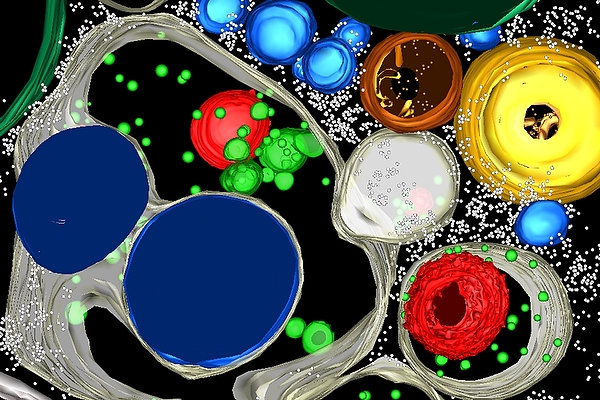Microscope will give UW researchers powerful view of molecular structures

This image produced by a three-dimensional electron microscope of a cell from a corn kernel helped UW–Madison botanist Marisa Otegui find important signaling proteins outside the parts of the cell with which they are usually associated.
A successful campus-wide partnership will bring to the University of Wisconsin–Madison a powerful new electron microscope equipped to produce high-resolution, three-dimensional images of a wide range of biological samples.
“It fills a prominent gap in our capabilities on campus,” said Marisa Otegui, a UW–Madison botany professor who must travel to Boulder, Colo., to peer at samples in her study of proteins used by plant cells for sensing and communication.
Common electron microscopes produce two-dimensional images in shades of grey from thinly sliced samples.
“The problem is every image is flat,” Otegui said. “If there are connections between features in your sample, you can’t see them. That’s an important limitation.”
Funded by a $1.5 million grant Otegui and a team of researchers won from the National Science Foundation, the high-resolution system bound for campus can handle far thicker — and even flash-frozen — samples.
The samples are bombarded by electrons while being tilted 60 degrees, an imaging approach often used in medical applications to produce images of the inside of people. A series of two-dimensional pictures of a sample are created, then combined to render the original sample in three dimensions.
“With that, you can calculate the surface area and distances between cellular structures. You can see how they fit together,” Otegui said. “It’s really useful, important information for a lot of researchers.”
The microscopes special “cryo” capabilities allow researchers to freeze samples.
“The rapid freezing process stops everything in place, so you can look at your specimen in as close to its native state as possible,” Otegui said. “It’s another powerful feature, as many of us must essentially kill our sample cells to look at them. And as soon as that sample is taken, things begin to change inside.”
Researchers from molecular virology, soil science, physics, zoology and the Laboratory for Optical and Computational Instrumentation joined in the grant proposal, and the network of users is expected to be even larger.
“It works so well as a shared resource,” Otegui said. “You collect your images, and then you spend a long time working with the data. One week at the microscope can give you data to work with for months and months.”
The new instrument will be housed in the College of Engineering’s Materials Science Center, and maintained with funding from the College and from the Morgridge Institute for Research, the private, non-profit half of the Wisconsin Institutes for Discovery.
“It’s such a good example of teamwork,” Otegui said. “We’ve got representatives from the College of Letters & Sciences, CALS, the medical school, Engineering, even the Morgridge Institute. We need more examples like that on campus.”
First of its kind in Wisconsin, the microscope should be installed by spring. This fall, Otegui and the grantees are hammering out details to purchase the instrument.
“In the future, we’re hoping to add more analytical features, like the ability to get elemental composition data from the scans,” she said. “We will acquire an instrument that will not only meet our current imaging needs but also future applications that — for now — we can only dream about.”
